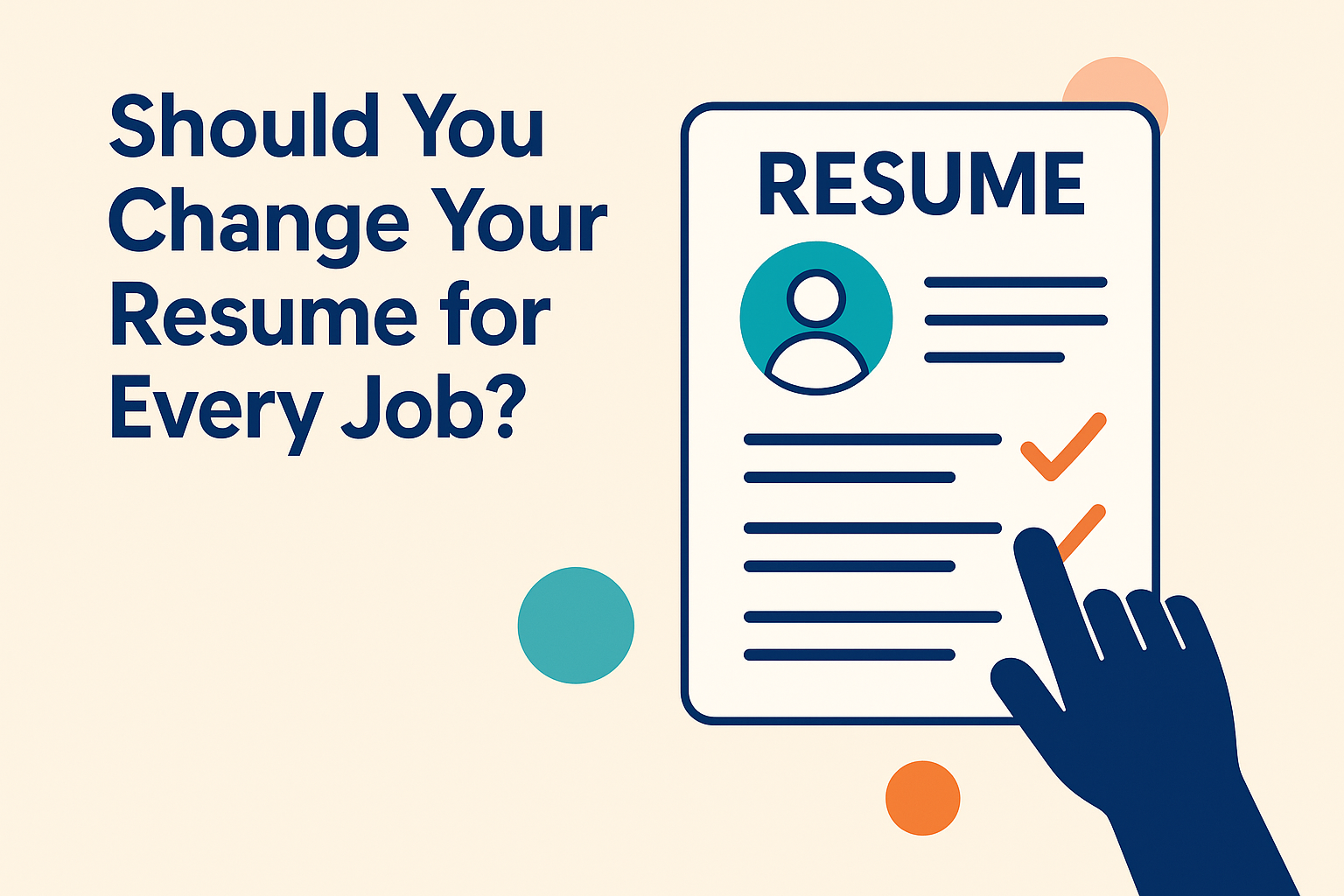Should You Change Your Resume for Every Job?
You've sent out dozens of resumes and heard nothing back. You start to wonder: Is it my experience? My format? Or should I actually change my resume for every job?

Here's the reality: according to LinkedIn's latest Hiring Trends Report, the average job posting receives more than 250 applications, and 75 percent of employers use automated screening systems before a human ever reads your resume. If you're submitting the same version each time, there's a good chance it isn't even being seen.
So, should you change your resume for every job?
Yes, but efficiently. You do not need to rewrite your resume for every role. Instead, use one strong foundation and adapt the title, summary, and most relevant accomplishments to reflect what each employer is looking for.
What You're Really Asking?
Many professionals ask, "Should you edit your resume for every job?" or "Should a resume be different for every job?"
In practice, both questions point to the same issue: balancing time and precision. Customization should highlight alignment with the job without requiring a complete rewrite. Small, targeted adjustments can make your resume appear specifically designed for that position.
When it is worth revising your resume
When to Customize Your Resume
| Situation | Time Investment | Impact |
|---|---|---|
| Strong match with background | 15–30 minutes | High |
| Similar positions | 5–15 minutes | Moderate |
| Career change | 30–60 minutes | High |
Why Customization Works?
Recruiters and technology evaluate resumes differently, but both look for the same thing: evidence of relevance.
Automated Screening Systems
Nearly three out of four employers use Applicant Tracking Systems (ATS). These systems scan resumes for exact phrases from the job description—such as software names, role titles, or certifications. When your resume uses those same terms naturally, it ranks higher and is more likely to reach a recruiter.
The Human Review
Once a resume passes the system, it faces a very quick test. Research from The Ladders shows that hiring managers spend about seven seconds deciding whether a resume deserves a closer look. This is sometimes called the seven-second rule in resume screening.
To make those seconds count, include the position title, a concise summary, and a few measurable accomplishments near the top of the page.
Resume Review Stages
| Stage | Focus | What to Include |
|---|---|---|
| ATS | Keyword accuracy | Use language directly from the job posting |
| Human | Clarity and value | Quantified results and clean formatting |
| Both | Relevance | Consistent phrasing and structure |
Example: Generic vs. Customized
Generic Statement
Managed multiple client projects across industries.
Improved Version
Managed eight software implementation projects using Agile methods, improving delivery time by 22 percent.
Small, precise wording changes show a clear connection between your background and the employer's needs.
When Over-Customization Becomes Counterproductive
Career strategist Stephanie Ciccone-Nascimento reminds professionals that speed matters, too. Spending hours adjusting every detail for one application may cause you to miss faster-moving opportunities.
If you are applying for nearly identical positions or working directly with a recruiter, use your main version with only minor updates.
Professional Tip: Update your summary, include the correct position title, and prioritize achievements that best demonstrate your value. This achieves relevance without unnecessary effort.
How to Analyze a Job Posting
A job description is essentially a list of what the employer values. Use it as a reference for how to revise your resume.
| Step | Action | Result |
|---|---|---|
| Identify | Highlight key skills and requirements | Clear checklist |
| Align | Match your experience to these areas | Stronger connection |
| Verify | Review the top section of your resume | Improved relevance |
How to Customize Your Resume Effectively
| Step | Action | Outcome |
|---|---|---|
| Title & Summary | Use the official job title | Immediate clarity |
| Experience | Lead with measurable achievements | Stronger first impression |
| Skills | Match posting language | Better screening performance |
| Final Check | Confirm key terms appear naturally | Ready for submission |
Private Sector and Federal Resumes
Different sectors require different approaches.
| Sector | Length | Focus |
|---|---|---|
| Private | 1–2 pages | Concise, results-oriented |
| Federal | 2+ pages | Detailed qualification coverage |
Time-Saving Resume Structure
Maintain a master version of your resume with all your experience, then adapt it for each opportunity. Create modular sections that you can copy and edit quickly.
| Method | Action | Benefit |
|---|---|---|
| Core Resume | Keep one comprehensive version | Easy editing |
| Modular Sections | Update relevant parts | Faster adjustments |
| Version Tracking | Use clear file names | Organized process |
How often should you change your resume?
Review it every few months or whenever you complete a major project, earn a certification, or shift career direction. Regular updates keep it ready for fast customization.
Changing Industries or Careers
When transitioning to a new field, focus on transferable skills and accomplishments that demonstrate adaptability.
Example:
Instead of "Handled customer inquiries," write "Resolved client requests across multiple departments, improving satisfaction scores by 18 percent."
| Focus | Action | Benefit |
|---|---|---|
| Summary | Lead with transferable results | Immediate relevance |
| Skills | Highlight technical and interpersonal strengths | Broader appeal |
| Validation | Add certificates or short courses | Proven readiness |
Making Your Resume System-Friendly
Formatting matters. To ensure automated systems can read your resume correctly:
- Use standard section headings like Experience, Skills, and Education.
- Stick to simple fonts and plain text bullets.
- Avoid graphics or tables that may block scanning.
- Include both abbreviations and full terms, for example: "CRM (Customer Relationship Management)."
| Section | Focus | Advantage |
|---|---|---|
| Headings | Use consistent labels | Clear structure |
| Keywords | Integrate naturally | Better parsing |
| File Format | Save as Word or standard PDF | Reliable compatibility |
Final Review Before Sending
According to Talent Inc., nearly eight out of ten hiring managers reject resumes that contain typos, and about one-third reject resumes that appear generic.
Before you submit, review the following:
- The position title matches the listing
- The top section includes measurable results
- Contact details and links are accurate
- The document is free of errors
| Step | Action | Outcome |
|---|---|---|
| Title Verification | Match with job posting | Immediate relevance |
| Proofreading | Read slowly and clearly | Error-free presentation |
| Formatting | Confirm consistent layout | Professional appearance |
When Customization Adds Little Value
If you are applying to multiple identical positions within one organization or responding to high-volume listings, focus on efficiency. Use your primary resume version and direct your energy toward networking and follow-up communication.
Summing Up
A professionally customized resume communicates clear alignment with an employer's needs. You do not have to rewrite your entire document for every opportunity; instead, apply the 80/20 principle, keep 80 percent of your content consistent and revise the top 20 percent to match each position.
Those concise, thoughtful updates show initiative and understanding, which significantly increase your chances of being invited to interview.
FAQ
Should you change your resume for every job?
Yes. Adapting your resume to each position highlights your fit and improves your screening results.
Should you edit your resume for every job?
Minor revisions, particularly to the summary and top achievements—create a more focused and relevant document.
Should a resume be different for every job?
It should vary slightly to match the expectations of each employer while maintaining consistent structure.
What is the seven-second rule in resume review?
Recruiters often decide within seven seconds whether to continue reading. Ensure the first section demonstrates clear value.
How often should you change your resume?
Update your resume every few months or after significant achievements to keep it accurate and competitive.
Final Thought
Adapt your resume with intention, not exhaustion. Focus on clarity, relevance, and measurable outcomes, and you will consistently present yourself as a professional who understands what employers are truly looking for.
Ready to Customize Your Resume?
Get expert help with resume tailoring and create a version that gets past ATS systems and impresses hiring managers.
Start Customizing Free